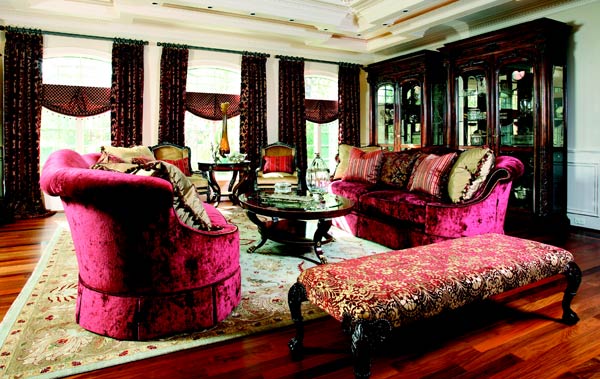With the advent of Home and Garden television, we have all seen shows on how to design the interior of our homes. In addition, there is an abundance of articles online and in magazines with names like “Design Tips,” “Design Trends,” and “Design 101.” It is, however, a little more difficult to learn what pitfalls to avoid before you even begin your design project. Below is a list of the top design pitfalls; a list of what NOT to do:
Don’t settle for blah if you love bold. Select colors that fit your personality and coordinate with things you love. Often, people “chicken out” and select too many neutrals because they are afraid they will get tired of the color. You are much more likely to get tired of blah neutrals than a color you love.
Don’t make your favorite color the main color. If you love aubergine, don’t paint the walls aubergine and purchase aubergine furniture. Instead, choose a more subtle color for the background and let your favorite color “pop” as a contrast.
Don’t paint first. Select your fabrics, upholstery, and area rugs first. There are thousands of paint colors to choose from and you can always have one custom mixed to go with your color scheme.
Don’t select the colors of paint, fabric, flooring, etc., in a store or design studio. Ask for samples and swatches of the items to take home and view in your home. You need to see how they look at different times of the day and in different lighting conditions. Many CFL light bulbs make colors look more green, while incandescent lighting tends to bring out the yellows.
Don’t push all the furniture up against the wall. You may think that a room will look larger if the middle of the floor is open, without furniture. But the opposite is true. Move the furniture into groupings in the center. Arrange a sofa with a table behind it. Move chairs out of the corners and you’ll have a more open, airy look in your room.
Don’t choose furniture that doesn’t fit. You wouldn’t wear clothes that are baggy or way too tight, so why would you try to make furniture that isn’t the right size work. Measure your space before you shop for furniture. You or your designer can draw the room to scale and include furniture that is the correct size and scale. Alternatively, you can tape the outline of furniture you are considering to see how it feels. Also, consider the ceiling height. If you have a ten foot ceiling you may not want a low back sofa. It will look silly in the room.
Don’t float a rug in the middle of the room. The elements in a room should not only be visually connected but also physically. The rug should be tucked under the front legs of sofas and chairs. This makes the room visually more attractive and also prevents a tripping hazard.
Don’t display every personal treasure. Select fewer, more important pieces. Although the temptation is to display all of the items you picked up on your many trips abroad, keep some of them in storage and swap them out from time to time. With less clutter each one will stand out more.
Don’t use too many patterns and prints. While you can use many patterns and prints in one room, it is important to balance large and or bold prints with solids, stripes, and smaller patterns.
Don’t invest heavily in trends. It’s okay to put one trendy piece in a room to give it a fresh, updated feel but too many trendy pieces will be expensive and painful considering the trends change all too often.
Don’t decorate with family heirlooms whether you like them or not. Your home should reflect who you are, not who your wealthy grandparents were. You may be able to work in a piece here or there but don’t feel obligated to keep a piece just because your parents or grandparents spent a lot of money on it when they purchased it.
Don’t forget the details. People often ask me why their room doesn’t look like the one in the picture. It is always the details that make the difference. Find interesting lamps, arrange books neatly, add decorative pillows to your furniture, and include candles and fresh flowers.
Don’t let someone make choices for you. Your home is your personal space and should be a reflection of your personal style. It is always good to get ideas, choices, and suggestions from friends, family and a professional interior designer but in the end, it is your home and you should feel comfortable there.
If you avoid these common mistakes you will have a home that you can be proud of and is a reflection of you and the way you live.
 About the Author: Cindi L Stephenson is a Senior Interior Designer at J. Hettinger Interiors in Danville. Her education includes a B.A. in City Planning, an M.B.A. in Marketing and a B.A. in Interior Design. Throughout years of International travel and post graduate study, Cindi has developed an understanding of traditions, culture, and design. “When you experience different cultures and different points of view, it opens up your perspective. Design should have a link with authenticity. I often add new materials and textures to create a fresh approach to the classics.” You can see Cindi’s portfolio at www.jhettinger.com. P 925.963.2147
About the Author: Cindi L Stephenson is a Senior Interior Designer at J. Hettinger Interiors in Danville. Her education includes a B.A. in City Planning, an M.B.A. in Marketing and a B.A. in Interior Design. Throughout years of International travel and post graduate study, Cindi has developed an understanding of traditions, culture, and design. “When you experience different cultures and different points of view, it opens up your perspective. Design should have a link with authenticity. I often add new materials and textures to create a fresh approach to the classics.” You can see Cindi’s portfolio at www.jhettinger.com. P 925.963.2147

